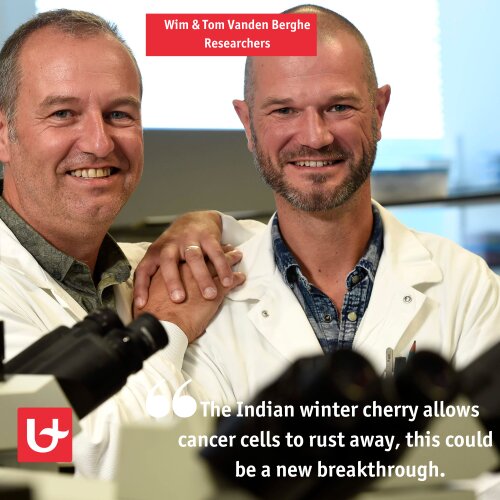
The Indian Winter Cherry – cancer rust project at the University of Antwerp is developing a therapy that literally allows cancer to rust away. Contrary to the known immunotherapy, in which the immune system helps to fight cancer, this cancer rust therapy is not yet used in hospitals. But due to the promising results from preclinical studies, there is currently a lot of investment in the development of rust-inducing drugs. The brothers Wim and Tom Vanden Berghe are partly responsible for this discovery that treatment-resistant cancers can rust away. Both with their own approach. Wim focuses on the use of active ingredients from medicinal plants that induce rust, while Tom develops innovative rust bombs in nano packaging so that they are delivered correctly to the tumor. The brothers themselves experienced first-hand what cancer can do to a person: Tom is still alive thanks to a targeted therapy developed by the biomedical sector.
Why we do what we do
“When cancer is given a face in your immediate environment in the family, with friends or colleagues, you are extra motivated to persevere and to look for solutions to problems or setbacks in the research”, agree Tom and Wim.
“Our research is based on observations from traditional plant medicine in India, Asia and Latin America, which we have given a modern twist. In the lab we tested about twenty commonly used “medicinal” plant extracts in search of new active cancer-killing ingredients. The Indian Wintercress (Withania somnifera) in particular proved to be very effective. This plant has also been used for 1000 years in India in Ayurvedic medicine for the treatment of skin ulcers,” says Wim.
Tom adds: “However, the interest in non-patentable natural products as anti-cancer therapy is very limited in the traditional pharmaceutical industry. That is why in my lab we also try to focus on developing rust therapies that can be more easily translated into clinical studies.”
The financial picture
“Natural plant compounds are the basis of various contemporary cancer drugs, such as taxol, vinblastine and camptothecin. It is a fact that nature is a unique laboratory. On the one hand for the evolutionary selection of biologically active metabolites against cancer targets and on the other hand for possible new basic structures for synthetic analogues with improved pharmaceutical properties. It can only benefit new applications. But there is no doubt that more financial support is needed.”
“The development of rust therapies is growing very fast, which naturally includes financial costs. Compared to America, a financial catch-up is needed in Europe to translate rust therapies to hospitals. We therefore also work closely with start-up companies to make this process as fast as possible. However, academic funding is the start of this entire process. And these resources are rather limited.”
A long-term investigation
Wim tells us the following: “After a four-year study, we finally managed to isolate and identify that one crucial cancer-killing component: Withaferin A. Curiously enough, Withaferin A did not appear to kill cancer cells like classical cancer drugs (chemotherapeutics). At this point, I enlisted the expertise of my brother Tom, who specializes in elucidating cancer cell death mechanisms. During this period, Tom and his team discovered a new type of cancer therapy via iron-dependent cell death: “ferroptosis” or cell death through biological rusting. Iron-addicted cancer cells die faster than normal cells due to rust holes in the cell membrane, which eventually disintegrate the cancer cell. The research gained momentum when it turned out that Withaferin A was able to disable the rust protection of the cancer cell and thus bring aggressive treatment-resistant tumors to the knees by stimulating “ferroptosis.”
The test phase and new developments
“We have now reached the point where we have already demonstrated the efficacy of Withaferin A in mice. In order to limit the side effects as much as possible, we camouflage Withaferin A in small fat globules or nanodroplets that enter the tumor via “leaky” blood vessels and on arrival disable the aggressive tumor cells by means of a rust avalanche.
In addition to the various cancer therapeutic applications with Withaferine A from Winter Cherry, promising results have recently been obtained with Mangiferine from the mango tree (Mangifera Indica) and Thalassioline B from the marine seaweed plant (Thalassia Testudinum). For this we work together with various (inter)national labs in Cuba and the University of Antwerp with the necessary knowledge in pharmacognos